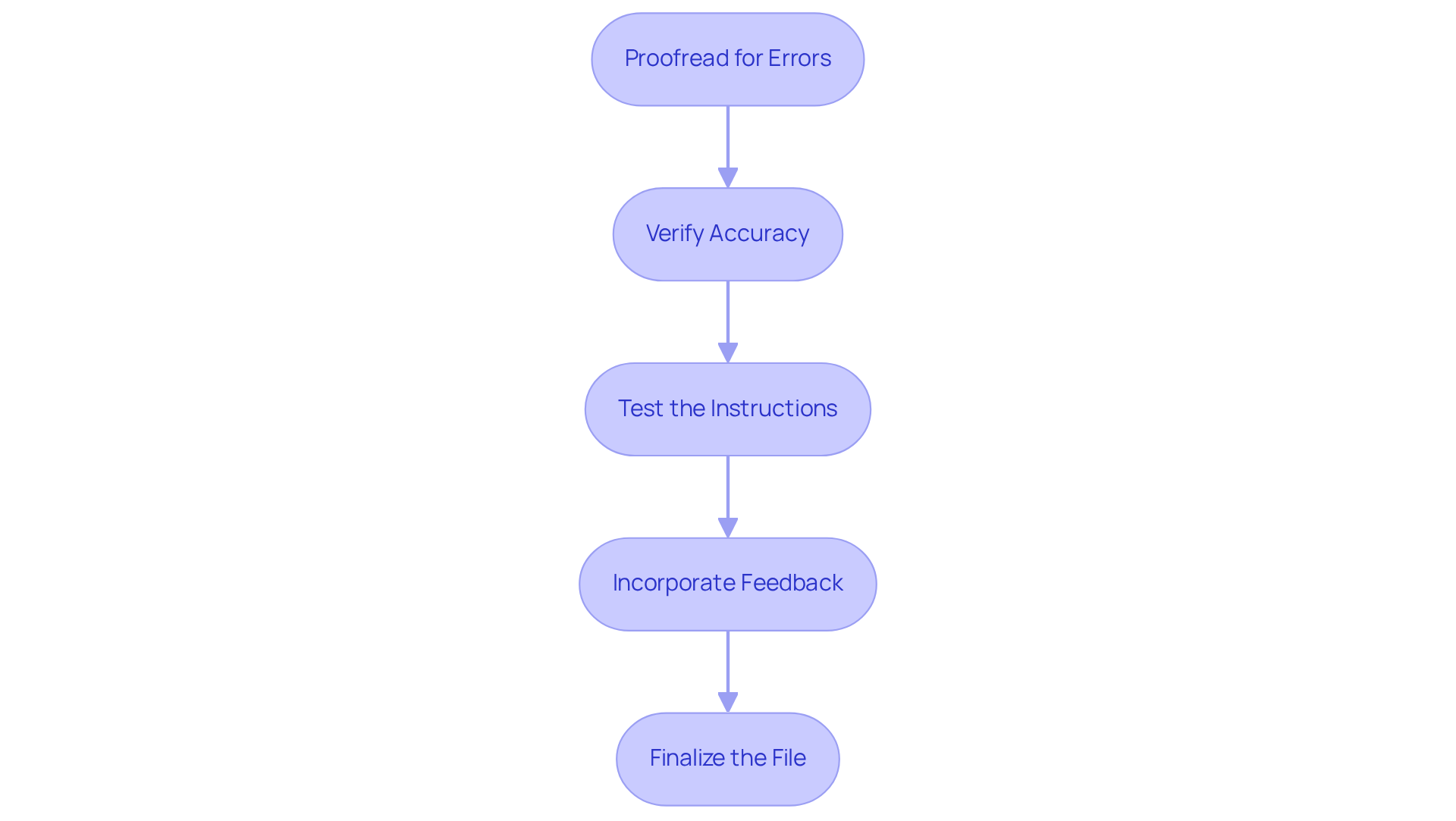
Overview
You might be wondering how to create effective documentation guidelines, right? Well, it’s all about including some key components like:
- A title
- Scope
- Audience
- Definitions
- Procedures
- Visual aids
- References
And don’t forget to follow a structured drafting and review process! Clear and organized guidelines really enhance communication and consistency within teams. This ultimately leads to improved operational efficiency and better knowledge management. So, let’s dive into how you can make your documentation shine!
Key Highlights:
- Guidelines serve as a roadmap for consistent and clear record-keeping, improving communication within teams.
- Key components for guidelines include title, scope, audience, definitions, procedures, visual aids, and references.
- Drafting guidelines involves outlining structure, writing clear instructions, using bullet points, incorporating visuals, reviewing for clarity, and seeking feedback.
- Reviewing guidelines should include proofreading for errors, verifying accuracy, testing instructions, incorporating feedback, and finalising formatting.
- Establishing a process for regular updates involves setting a review schedule, assigning responsibility, monitoring changes, requesting user input, and documenting updates.
Introduction
Creating effective documentation guidelines is super important for keeping things clear and consistent in any organization. You might be wondering how these guidelines can actually help—well, they act like a roadmap, making processes smoother and boosting communication among team members. But let's be honest, crafting a guideline that really hits home and meets the needs of its users can feel like a big challenge.
So, what are the key components that ensure these documents not only inform but also engage and empower users? In this article, we’re going to dive into the steps you need to take to create impactful guidelines that elevate your documentation practices and foster a more efficient workflow.
Understand the Purpose of Guidelines in Documentation
You might be wondering how to make a guideline that can truly impact record-keeping. Well, they’re like a roadmap that helps ensure everything is consistent, clear, and easy to use. By establishing a common understanding of record-keeping methods, these recommendations can really cut down on confusion and boost communication within teams.
For example, in a software development environment, clear instructions can outline how to document code changes, so everyone’s on the same page. This kind of consistency not only makes collaboration smoother but also helps new team members jump right in, quickly grasping the writing style and what’s expected of them.
So, when you have well-defined protocols that demonstrate how to make a guideline, you’re looking at improved documentation consistency, leading to a more organized and efficient workflow across the board. Now, isn’t that something worth exploring further?

Identify Key Components for Your Guideline Structure
When you're putting together guidelines, you might want to think about including these key components:
- Title: Clearly state what the directive is all about.
- Scope: Define what the framework covers and any limitations it might have.
- Audience: Identify who the guideline is meant for, making sure it meets their needs.
- Definitions: Provide definitions for any technical terms you use.
- Procedures: Outline step-by-step instructions for the activities you’re documenting.
- Visual Aids: Incorporate diagrams or flowcharts to help illustrate complex processes.
- References: List any documents or resources that support the protocol.
By including these components, you demonstrate how to make a guideline that creates a solid structure boosting clarity and usability. So, what do you think? Are you ready to dive into how to make a guideline that is effective?

Draft Your Guideline: Step-by-Step Instructions
To draft your guideline effectively, let’s walk through some simple steps together:
- Outline the Structure: Start by crafting a solid outline that includes all the essential elements for your writing. This foundational step makes sure your guideline is both comprehensive and organized.
- Write Clear Instructions: Use straightforward language to explain each step. Keep it simple—avoid jargon unless it’s absolutely necessary, and if you do use any technical terms, be sure to define them to help everyone understand.
- Use Bullet Points: Break down complex information into bullet points. This format makes it easier to read and allows users to quickly grasp the key points. Research shows that clarity in written materials can really cut down on errors and misconceptions.
- Incorporate Visuals: Spice up your documentation with diagrams, flowcharts, or screenshots when it makes sense. Visual aids can really boost comprehension and retention, making it simpler for users to follow along with the processes you’ve documented.
- Review for Clarity: Once you’ve drafted everything, take the time to review your guideline thoroughly. Make sure it flows logically and is easy to follow. This step is super important because effective record-keeping can lead to happier employees by reducing confusion.
- Seek Feedback: Don’t hesitate to share your draft with colleagues or stakeholders to get their input. Getting others involved in the review process can help pinpoint areas for improvement and ensure that your documentation meets the needs of its users.
By following these best practices, you’ll understand how to make a guideline that’s not only informative but also user-friendly. This ultimately boosts operational efficiency and fosters better team collaboration. So, let’s get started on making your guidelines shine!

Review and Revise Your Guideline for Clarity and Accuracy
To make sure your guidelines are clear and spot-on, let’s walk through some essential review and revision steps together:
- Proofread for Errors: You might be wondering why this is so important. Well, taking a moment to check for spelling, grammar, and punctuation mistakes is crucial—after all, even tiny errors can shake the credibility of your written materials.
- Verify Accuracy: Next up, confirm that all your information is correct and up-to-date, especially those technical details or procedures. Inaccurate documentation? That can lead to some serious misunderstandings and operational hiccups.
- Test the Instructions: If you can, have someone who’s not familiar with the process try following your guideline. This practice helps spot any confusing areas and ensures that your instructions are user-friendly.
- Incorporate Feedback: Don’t forget to use the feedback you gathered during the drafting phase to make those necessary improvements. Chatting with colleagues can provide valuable perspectives that boost the clarity and effectiveness of your text.
- Finalize the File: Once you’ve wrapped up your revisions, take a moment to format it for consistency and clarity, ensuring it sticks to any established style guides. A well-structured document not only enhances readability but also reinforces how reliable your information is.
By thoroughly reviewing and revising your framework, you’re not just checking boxes—you’re significantly enhancing how to make a guideline that improves its effectiveness and reliability, which ultimately leads to better knowledge management and operational success. So, let’s get to it!

Establish a Process for Regular Updates and Maintenance
To keep your guidelines relevant and accurate, you might be wondering how to make a guideline for a solid maintenance process. Here’s a friendly roadmap to get you started:
- Set a Review Schedule: How often should you evaluate the instructions? Think quarterly or bi-annually—whatever fits your needs best!
- Assign Responsibility: It’s important to designate a team member or group to oversee updates and maintenance. Who in your team would be perfect for this?
- Monitor Changes: Keep an eye on any changes in processes or regulations that could impact your standards. Staying informed is key!
- Request Input Frequently: Encourage users to share their thoughts on the recommendations. This way, you can pinpoint areas for enhancement together.
- Document Changes: Don’t forget to maintain a log of updates made to the guidelines. It’s all about transparency and reference.
By establishing a regular update process, you ensure that your documentation remains a valuable resource for understanding how to make a guideline for your organization. Now, let’s dive into how this can really benefit you!

Conclusion
Creating effective documentation guidelines is super important for keeping things clear, consistent, and efficient in any organization. You might be wondering how these guidelines can really make a difference. Well, by understanding their purpose and structure, teams can seriously boost their record-keeping processes. The article laid out a solid approach, highlighting the need for clear protocols that help streamline communication and collaboration among team members.
So, what are the key components for crafting these effective guidelines? Think of:
- A clear title
- A defined scope
- A detailed breakdown of procedures
- Visual aids and references
The step-by-step instructions in the article really drive home the importance of drafting, reviewing, and revising guidelines to keep them clear and accurate. Plus, regular updates ensure that your documentation stays relevant and useful over time.
In a world where effective communication is key, you can't underestimate the value of well-structured guidelines. By putting these practices into action, you not only boost operational efficiency but also nurture a culture of collaboration and continuous improvement. So, why not take the plunge? Start developing your own guidelines today, and make sure everyone has the tools they need for success!
Frequently Asked Questions
What is the purpose of guidelines in documentation?
Guidelines serve as a roadmap to ensure consistency, clarity, and ease of use in record-keeping. They help establish a common understanding of methods, reduce confusion, and enhance communication within teams.
How do guidelines benefit teams in a software development environment?
In software development, clear guidelines can outline how to document code changes, ensuring everyone is aligned. This consistency facilitates smoother collaboration and helps new team members quickly understand the writing style and expectations.
What are the key components to include when creating guidelines?
Key components to include are: - Title: Clearly state the directive's purpose. - Scope: Define what the framework covers and any limitations. - Audience: Identify who the guideline is intended for. - Definitions: Provide explanations for technical terms. - Procedures: Outline step-by-step instructions. - Visual Aids: Use diagrams or flowcharts for complex processes. - References: List supporting documents or resources.
How do these components improve the effectiveness of guidelines?
Including these components creates a solid structure that boosts clarity and usability, making the guidelines more effective for the intended audience.
👍
What others are liking
5 Steps to outline your ideal documentation structure
5 MINS READ
Where to start the your journey of mapping out your ideal documentation structure, aligning it with the very heartbeat of your organization?
Defining a winning level of detail in your process
3 MINS READ
What is too much detail, and what is too little? This article described in that winning level detail about what detail is enough.





